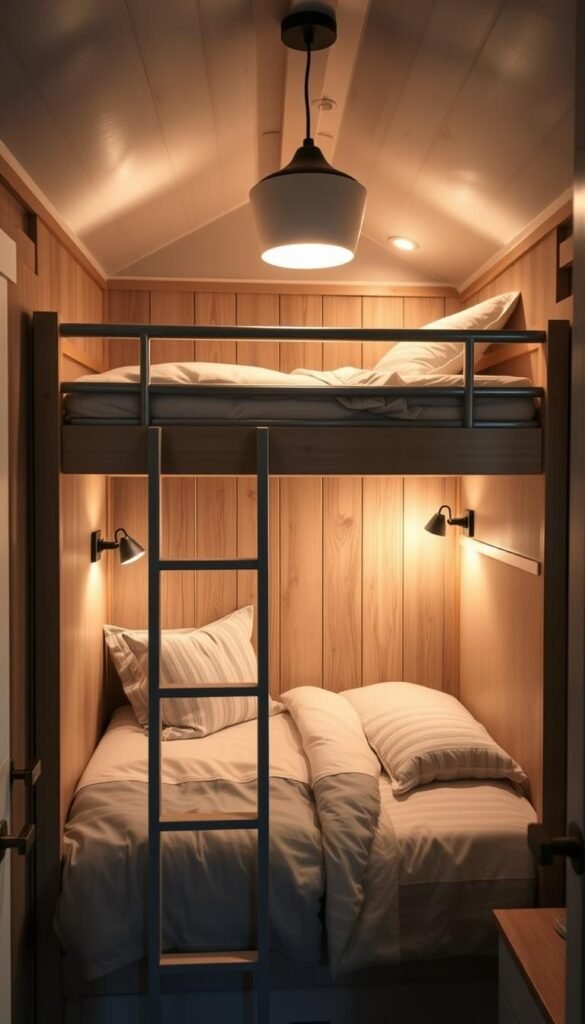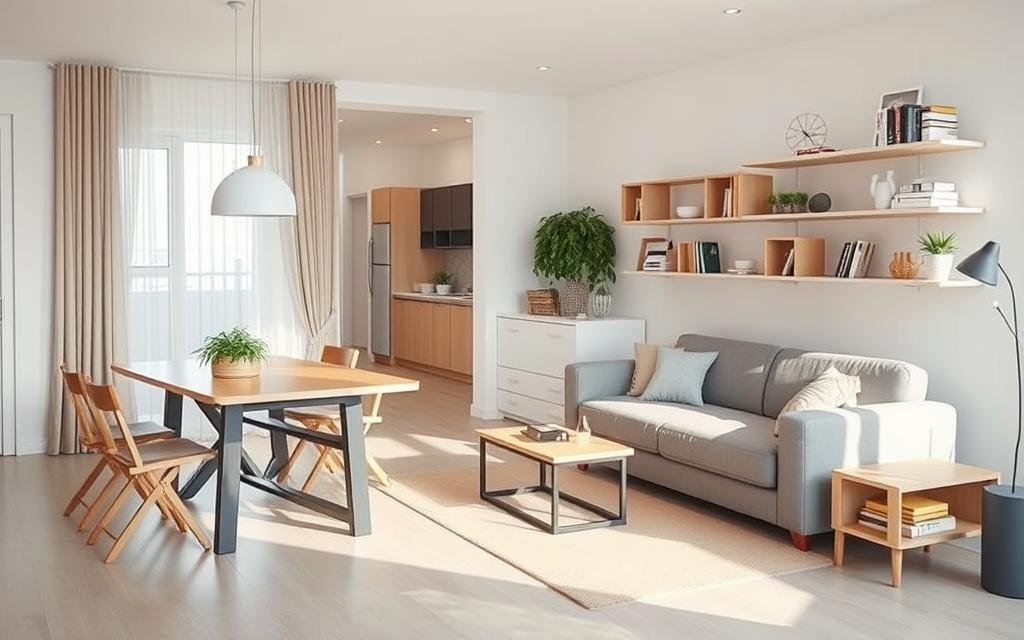Families embracing minimalist lifestyles often struggle to balance comfort with limited square footage. As more parents choose compact living arrangements, finding functional sleeping setups becomes critical. Creative designs now allow multiple children to share tight quarters without sacrificing play areas or storage.
This guide showcases innovative approaches that transform cramped rooms into cozy retreats. From modular units to vertical configurations, these ideas help families avoid common space-planning pitfalls. Safety remains paramount, with features like guardrails and sturdy ladders integrated into every concept.
Options range from basic weekend projects to custom-built installations. Many designs incorporate study nooks or hidden storage, proving that small spaces can serve multiple purposes. The best solutions encourage childhood independence while letting parents maintain easy supervision.
Key Takeaways
- Compact homes require smart furniture that serves multiple functions
- Vertical designs maximize floor space for play and activities
- Safety features should never be compromised in small-space sleeping solutions
- Customizable options adapt to children’s changing needs over time
- Creative layouts can foster independence while maintaining parental oversight
Introduction: Maximizing Space with Style and Functionality
In tight quarters, innovative furniture becomes the cornerstone of functional living. Tiny homes challenge families to rethink traditional layouts, blending sleep zones with play areas through vertical solutions. Multi-functional designs prove essential when floor space measures less than 300 square feet.
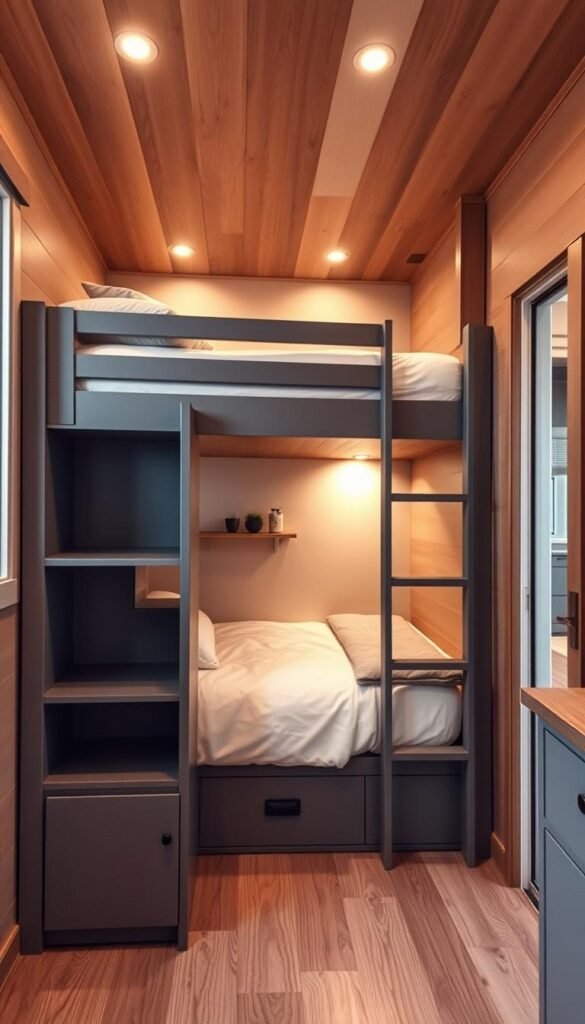
The Importance of Smart Design in Tiny Homes
Traditional bedroom setups consume precious square footage in compact houses. Clever configurations use vertical space for sleeping while leaving room below for desks or storage. Built-in ladders and guardrails ensure safety without bulky additions.
Children thrive when their environment supports both privacy and family interaction. Thoughtful layouts create personal nooks within shared spaces, maintaining a sense of normalcy. This balance helps young ones adapt to unconventional living arrangements.
Why Creative Bunk Bed Ideas Matter for Kids
Innovative sleep solutions do more than save space—they foster independence. Raised beds with integrated study areas let children claim their own territory. Some designs even convert into guest sleeping spots when relatives visit.
| Feature | Traditional Bed | Smart Bunk Solution |
|---|---|---|
| Floor Space Used | 45 sq ft | 22 sq ft |
| Storage Options | Under-bed only | Built-in drawers & shelves |
| Adaptability | Fixed layout | Modular components |
Parents appreciate easy nighttime access through strategic ladder placement. Durable materials withstand energetic play, proving that small-space living doesn’t mean compromising quality. These designs grow with children, adapting to evolving needs over time.
8 Bunk Bed Designs Perfect for Kids in Tiny Homes
In small homes, every inch must serve multiple purposes while maintaining a welcoming atmosphere. Clever sleeping arrangements balance safety with flexibility, allowing rooms to shift from play zones to study areas effortlessly. Space-saving configurations often become the heart of compact family living.
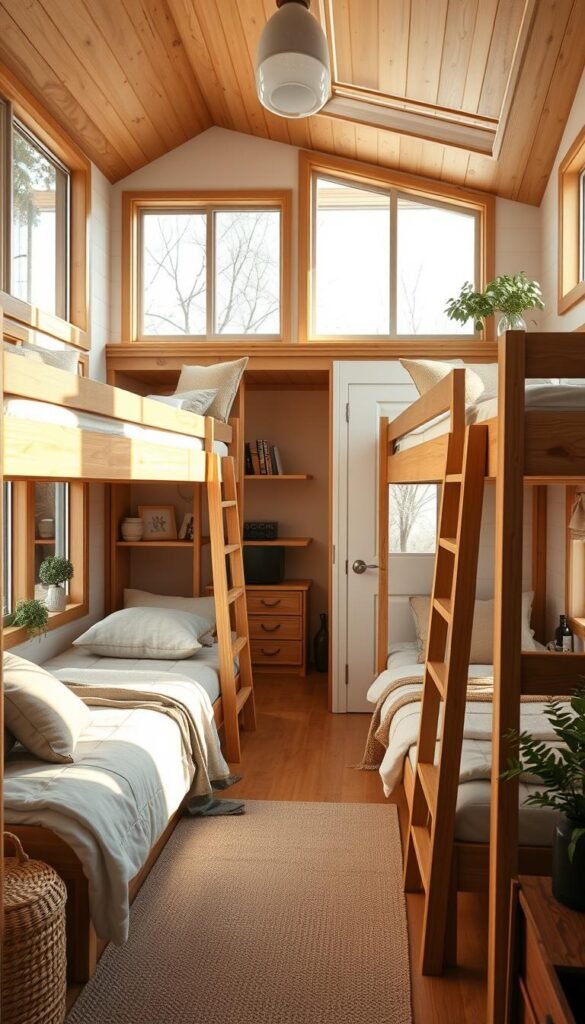
Exploring Design Options and Benefits
Vertical fold-out units disappear into walls by day, creating instant play space. Horizontal systems tuck neatly under lofts, ideal for homes with lower ceilings. Sofa conversions work double duty, providing seating by sunlight and sleeping spots at night.
Triple-decker setups challenge height restrictions but maximize sleeping capacity. Slide-out frames on casters adapt to daily routines, while corner-cut shapes hug irregular walls. Each custom solution addresses unique spatial challenges faced by growing families.
Features That Appeal to Tiny Home Living
Modern designs prioritize adaptability without sacrificing durability. Thick foam mattresses fit snugly into foldable frames, while breathable fabrics maintain comfort. Built-in USB ports and reading lights add functionality to compact sleep nooks.
| Design Feature | Traditional Home Use | Tiny House Adaptation |
|---|---|---|
| Footprint | Permanent placement | Collapsible structure |
| Storage | Separate dressers | Integrated compartments |
| Access | Fixed ladders | Retractable steps |
| Materials | Solid wood | Lightweight alloys |
Guardrails blend seamlessly into modern aesthetics, using tension rods instead of bulky frames. Modular components let parents rearrange layouts as children grow. These innovations prove that smart design can make cramped quarters feel surprisingly spacious.
Detailed Bunk Bed Ideas for Creative Tiny House Interiors
Compact living demands furniture that disappears when not in use. Clever fold-out systems and multi-purpose configurations help families reclaim floor space during active hours. These designs blend seamlessly into daily routines while maintaining essential comfort after dark.
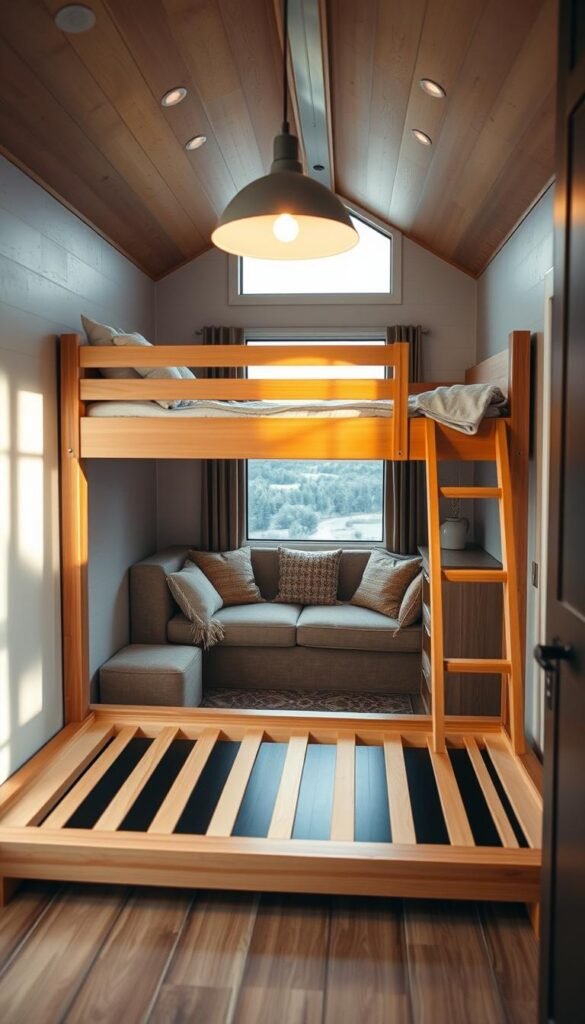
Vertical and Horizontal Fold-Out Concepts
Wall-mounted solutions save crucial square footage through smart engineering. Vertical models swing down from ceilings, needing at least 8-foot heights for safe operation. Horizontal versions slide out from wall cavities, ideal for rooms with standard dimensions.
Some designs feature dual-purpose surfaces. Folded units become chalkboards or shelving during daylight. This approach eliminates the need for separate play areas and sleeping zones.
Sofa-Bunk, Triple Decker, and Slide-Out Innovations
Convertible sofa units solve seating and sleeping needs simultaneously. By night, cushions rearrange into twin-sized beds with hidden support frames. Triple-tier systems stack sleeping platforms vertically, adding 50% more capacity without extra floor space.
| Design | Space Saved | Best For |
|---|---|---|
| Vertical Fold-Out | 28 sq ft | Tall ceilings |
| Sofa-Bunk Hybrid | 18 sq ft | Multi-use areas |
| Slide-Out Frame | 15 sq ft | Narrow rooms |
Incorporating Curtains, Windows, and Corner Cuts
Textile partitions create private nooks without permanent walls. Lightweight curtains on ceiling tracks let children personalize their sleep areas. Strategic windows near upper bunks bring natural light but require structural planning during construction.
Angled cut designs fit snugly into awkward corners. These space-efficient shapes leave room for dressers or toy chests below. Combined with retractable ladders, they maximize every inch of compact layouts.
DIY Inspiration: Built-In Bunks and Custom Installations
Custom sleep solutions transform cramped areas into functional zones through smart carpentry. A beach house project proves two XL twin mattresses can fit in 7-foot-wide rooms using wall-mounted platforms. This approach maintains floor space while creating secure sleeping levels.
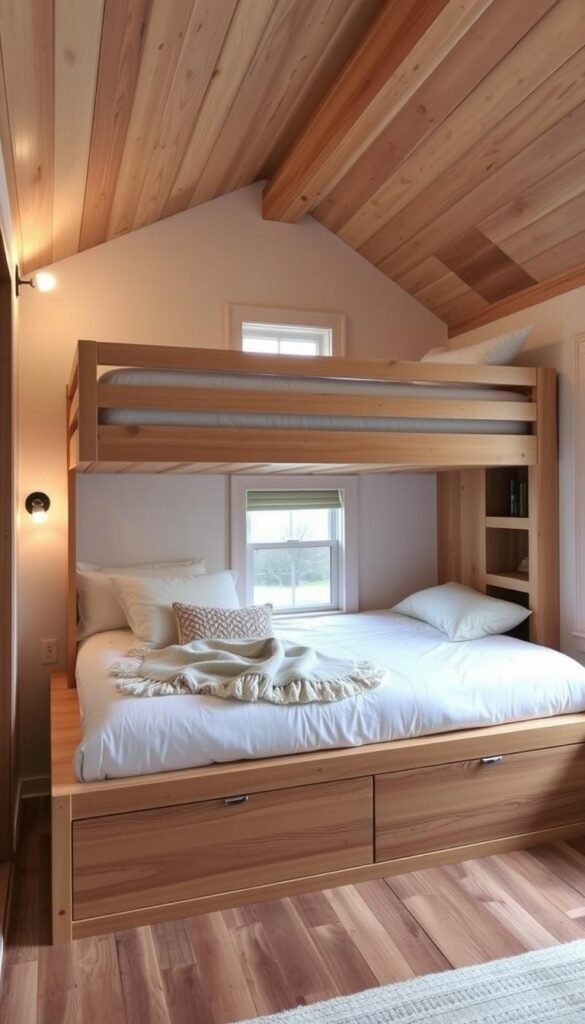
Step-by-Step Platform and Ladder Construction
Start by building 2×4″ frames with cross-braces every foot. Secure 1/2″ plywood atop each platform using structural screws. The floating design attaches three sides directly to wall studs, eliminating bulky support posts.
Measure headroom carefully: 34.5″ clearance below the top bunk prevents bumped heads. The bottom bunk sits 17″ high, allowing easy access for younger children. Use levels throughout installation to ensure perfect alignment.
Materials, Tools, and Finishing Touches
Essential supplies include 1×8″ primed boards for trim and 2×2″ pine for ladders. A pocket hole jig creates invisible joints, while bar clamps hold pieces during assembly. The ladder’s 12″ rung spacing ensures safe climbing.
Final details matter. Cover exposed edges with lattice strips and reinstall baseboards for polished looks. Underside panels hide framing while maintaining airflow around mattresses. Total costs stay under $250 excluding bedding.
Exploring Additional Space-Saving Sleeping Options
Innovative sleep solutions extend beyond traditional setups in compact homes. Clever designs now let families reclaim floor space without sacrificing comfort. These approaches work particularly well in layouts where every square foot serves multiple purposes.
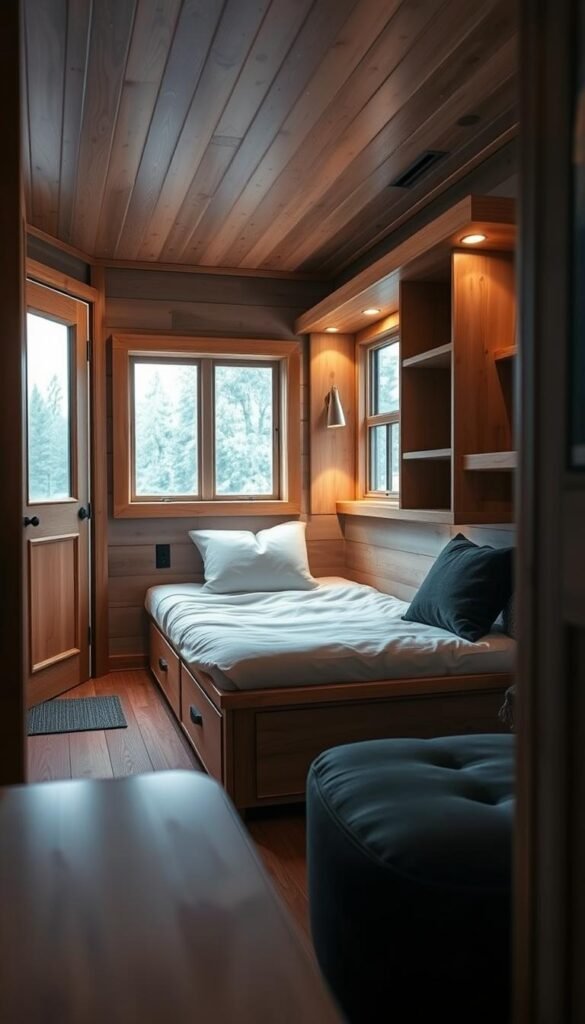
Murphy Beds, Roll-Out Options, and Multi-Functional Furniture
Wall-mounted Murphy beds disappear completely during daytime hours. Their hinged mechanisms fold vertically, often blending with decorative panels. This approach clears floor space but requires nightly setup.
Roll-out systems hide beneath raised kitchen floors or seating areas. These ground-level options eliminate climbing but feel more temporary. Some models use air mattresses for easier storage.
| Solution | Space Saved | Best Use Case |
|---|---|---|
| Murphy Bed | 40 sq ft | Multi-use rooms |
| Roll-Out Bed | 28 sq ft | Kitchen extensions |
| Sofa Bed | 22 sq ft | Living areas |
Integrating Storage with Beds in Compact Spaces
Platform beds with built-in drawers solve two problems at once. These designs provide sleeping surfaces while storing seasonal clothing or toys. Some models include pull-out desks for homework areas.
Sofa conversions shine in daytime-to-nighttime transitions. Folding cushions reveal hidden mattresses, while armrests often contain charging stations. Cable-operated systems lower beds from ceilings, ideal for mobility needs.
| Storage Feature | Capacity | Access Method |
|---|---|---|
| Under-bed drawers | 150L | Side pull |
| Headboard shelves | 20L | Open front |
| Lift-up platform | 300L | Hydraulic lift |
Conclusion
Compact living challenges families to rethink conventional furniture through smart design that prioritizes safety and adaptability. The showcased concepts prove comfort thrives in small spaces when vertical solutions merge with multi-functional elements. Guardrails, retractable ladders, and modular components address unique needs while preserving precious floor areas.
DIY enthusiasts can implement basic platforms using common tools, while complex installations may require professional expertise. Built-in compartments beneath mattresses or within ladder frames keep belongings organized without cluttering rooms. Every design emphasizes emergency accessibility, ensuring safe exits during unexpected situations.
Adaptable systems shine through convertible features that shift with daily routines. Fold-away beds create instant play zones, while slide-out frames maximize narrow corridors. These innovations demonstrate how thoughtful layouts foster independence in children without compromising parental oversight.
Ultimately, elevated sleeping solutions transform cramped quarters into efficient living environments. By blending storage integration with space-conscious engineering, families craft nurturing spaces where functionality and imagination coexist seamlessly.
